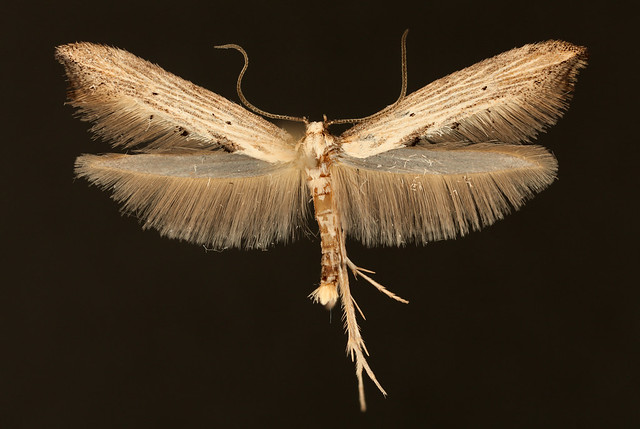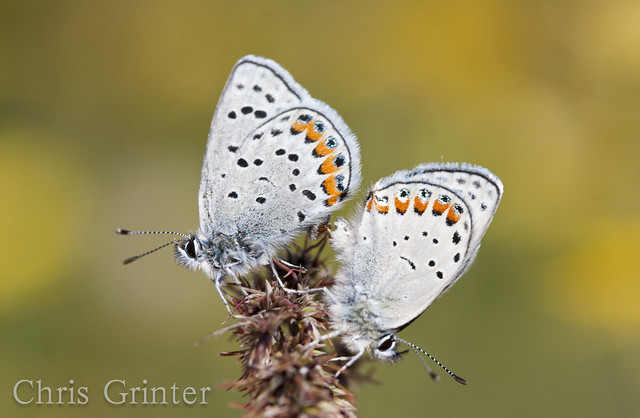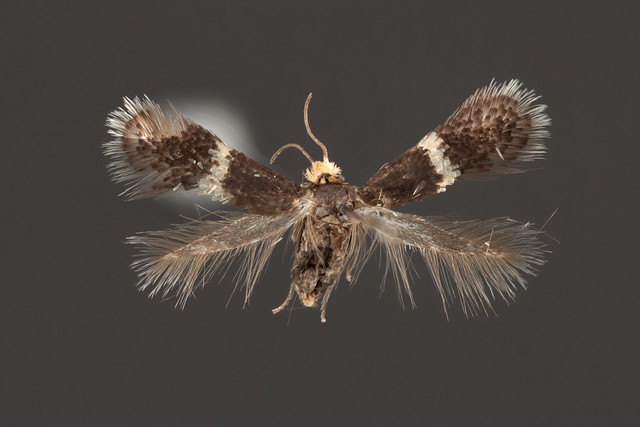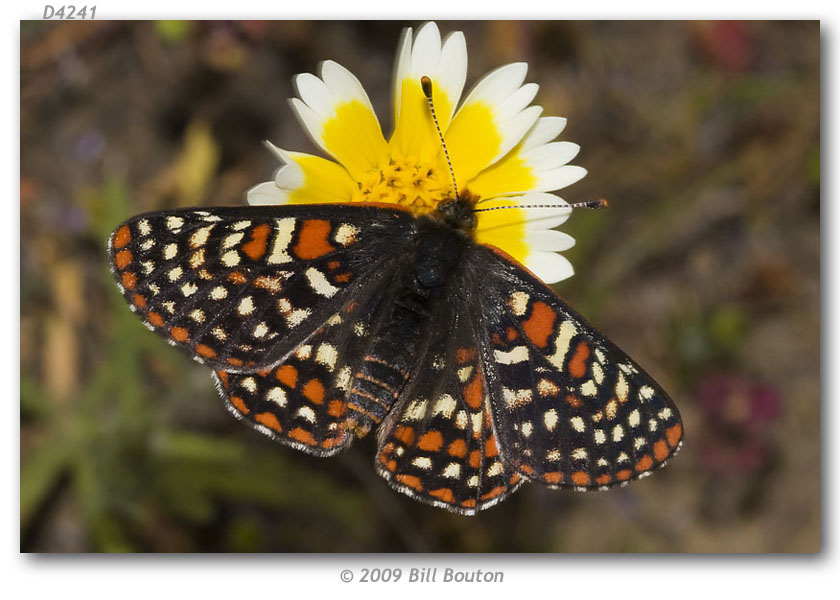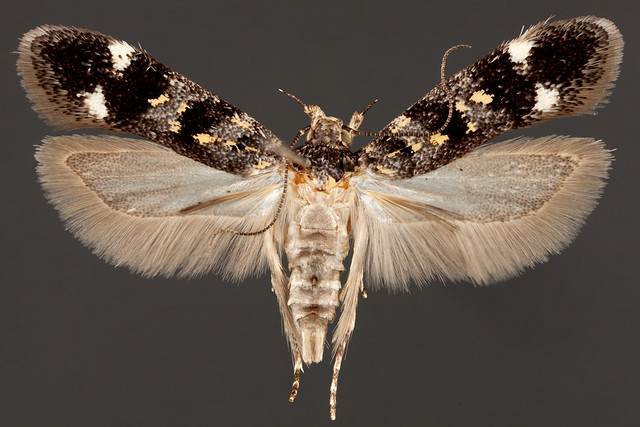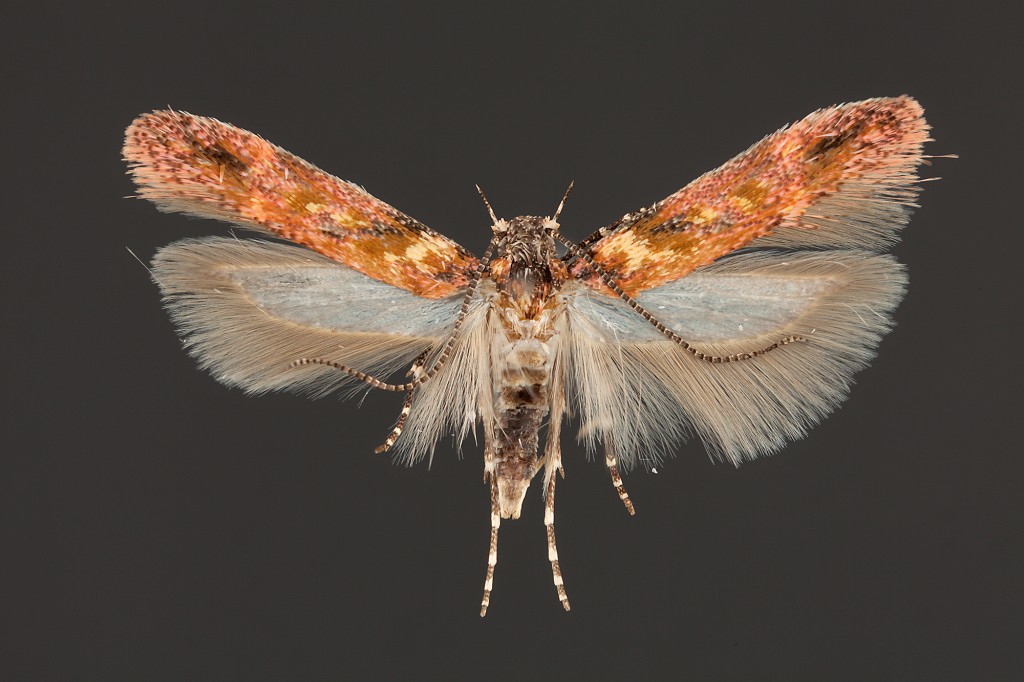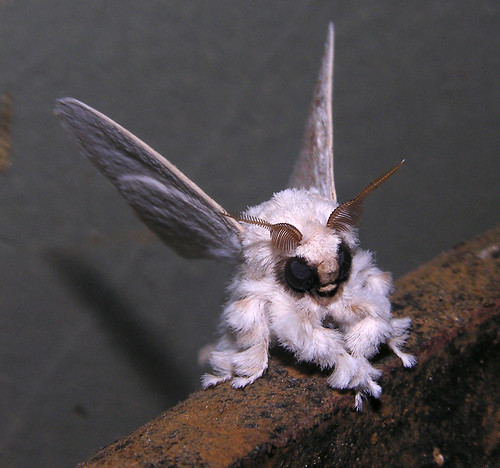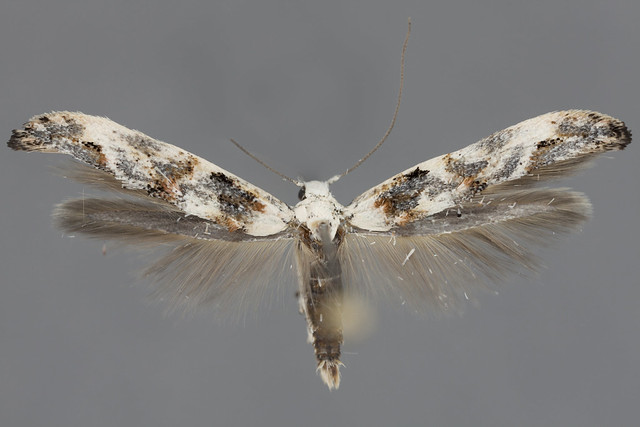Traça de hoje é uma espécie de belas montanhas rochosas fora de Denver, Epermenia stolidota (Epermeniidae). Esta é realmente uma maior espécime do que parece, cerca de 20 mm de asa a asa. Aqueles levantou, escureceu, tufos de escamas na borda posterior da asa anterior é um grande personagem para esta família, , bem como a rigidez cerdas na tíbias (também um pouco visível aqui). Tem 11 espécies 2 géneros nos Estados Unidos, com probabilidade um pouco mais para ser descoberto. Fellow assistente curatorial David Bettman introduzido desta espécie, utilizando a revisão das espécies nearticas: PDF aqui.
|
Esta semana eu estou compartilhando uma pequena, mal vestido, e semi-competentemente espalhados Nepticulidae no gênero Estigma da mesma armadilha de luz de Prescott Arizona que as últimas Monday Moths. Eu geralmente não compartilhar uma foto de uma mariposa que não está na melhor condição, mas estou usando isso como um exemplo de técnica. Não só esta mariposa de 4 mm foi retirada do fundo de uma armadilha de luz, mas foi alfinetado e seco por mais de um ano e meio. Sempre ouvi dizer que pode ser quase impossível lidar com o menor dos pequenos; e na maioria das vezes eu não tenho. Eu costumava pensar que você precisa capturá-los de uma folha de luz viva em um frasco e sacrificar momentos antes de espalhar, tudo enquanto nunca, nunca deixá-los secar um pouquinho antes. Mas ao que tudo indica, você pode se safar com um espécime decente relaxando 24 horas e espalhando de cabeça para baixo. É claro que se você tiver um espécime perfeitamente fresco que evitasse o liquidificador de uma armadilha de balde, seria um espécime muito superior. Melhor ainda, você puxou a mina de folhas e criou a mariposa você mesmo. A maioria desses Nepticulidae é específica do hospedeiro e muito mais diversificada do que lhes demos crédito. Ouvi dizer que poderia haver pelo menos 100 nova espécie aguardando descoberta apenas nos EUA. The story of many San Francisco butterflies are well known and depressing. The area has been heavily impacted by human development for over two centuries and is the infamous home to the first known example of an extinct American butterfly, o Xerces blue. While other butterflies are hanging on, or getting help to hang on like the Missão Azul, some like the Bay Checkerspot have continued to decline despite valiant efforts for reintroduction. Hoje, the only known colony of the Bay Checkerspot is within Santa Clara County on a site called Coyote Ridge. It was twenty one years of intensive study of the checkerspot in the 1960’s and 70’s by the famous biologist Paul Ehrlich that provided the impetus for federal listing in 1987. A partir de 1998 the colonies he studied have since gone extinct. Here is an excerpt from a 1980 paper in the Journal of the Lepidopterists’ Sociedade “Two California Checkerspot Butterfly Species, One New, One on the Verge of Extinction” (.pdf).
All efforts to relocate this butterfly have failed, and the future of this animal is not looking bright. And so what exactly is this creatures name? In 1937 Robert F. Sternitzky described what he thought to be an overlooked San Francisco butterfly “Euphydryas editha var. bayensis“. Those early descriptions of variations and races are roughly equivalent to today’s subspecies – and so the butterfly remained bayensis for decades and became a mascot for conservation. But where was the very first Euphydras editha from and how did the San Francisco bayensis differ? Unfortunately the original description is vague and the collecting locality is simply listed as “Califórnia”, as was the unfortunate habit of Boisduval who described the butterfly 1852. But all hope is not lost since the famous French Lepidopterist was having specimens sent to him by the earliest California Lepidopterist, Pierre Joseph Michel Lorquin. An eager gold prospector and butterfly collector, Lorquin traveled California from 1849 para 1858 and again in 1869. Every butterfly that was sent back to France was a new species and subsequently described by Boisduval – who of course named one of California’s most beautiful butterflies after Lorquin. Enter Emmel, Emmel and Mattoon in 1994 who were writing the Systematics of Western North American Butterflies. In the process of cleaning up the mess of these early western species they had to designate a Lectotype for E. editha editha since Boisduval never fixed a Holotype in 1852. Essentially he named a new species without designating the taxonomic standard for the group, making future work ambiguous for taxonomists. Thankfully the travels of Lorquin have roughly been documented and we can ascertain that he should have been in San Francisco around 1849. Comparisons of the original specimens to the Bay Checkerspot made for an overwhelming case that it was this butterfly that was sent to France in the 19th century. The result of this finding therefore places the Bay Checkerspot Euphydryas editha bayensis into synonymy with the older name Euphydryas editha editha. The name bayensis effectively dissappeared because it was a re-description of a butterfly that was already known. Euphydryas e. editha as it turns out has been known from coastal California from the bay region down to San Luis Obispo – and so voila, the range of the Bay Checkerspot just exploded. But of course the story isn’t that simple and the butterfly didn’t become magically safe with a name change. Conservation groups and ecologist kicked and screamed and refused to accept the change, even the Xerces Society hasn’t jumped on board with the consensus of taxonomists out of what I can only assume is fear of the appearance that their butterfly is no longer endangered. I’ll emphasize that this doesn’t mean that the populations in the bay are no longer threatened – there is still a need for protecting these biologically significant populations as they are significantly declining. Habitats all throughout the region are facing ongoing and pernicious threats (pdf). All in all the name change is trivial, we can now call the Edith’s Checkerspot the Bay Checkerspot, and still fight to protect this butterfly. I’m unsure of what would be required to amend the federal register, and if it’s at all possible to expand protection of an animal like this without re-petitioning the endangered species act. So perhaps I can understand the failure to embrace the name change since from the outside it looks like their bug is no longer endangered. Por outro lado, this could bring attention to populations of a butterfly that have been overlooked for decades.
Many thanks to John Pelham for conferring with me over this taxonomic headache.
Como cerca de um outro não identificado Gelechiidae do mesmo local que a amostra anterior (Não.. Prescott Arizona). I’m taking a stab at this moth being in the genus Chionodes – and it is superficially similar to the species C. continuar. Felizmente há uma monografia deste grupo (Traças da América do Norte do México, fascículo 7.6) and I will be able to dissect and hopefully arrive at a better identification. The genitalia of moths are wonderfully sclerotized structures that can provide a wealth of characters used for identification. I’ll have to be sure to share images of what the genitalia look like soon!
Esta traça é um bom exemplo do que um monte de minhas mariposas são no momento – não identificado! Este é certamente um Gelechiidae, é possível ver os palpos grandes viradas na parte da frente da cabeça, e uma projecção em forma de dedo sobre as pontas das asas posteriores. Apenas sobre uma das famílias mais fáceis de microleps para identificar. E de uma gestalt geral talvez isso esteja no Gnorimoschemini? Se alguém reconhecer esse garotinho por favor me avise, caso contrário, vou atacar a literatura para tentar rastrear o nome. Esta bela mariposa é das montanhas fora de Prescott, A – Julho 2010. Bastante agradavelmente, existem tantos microlepidópteros que não são facilmente identificados. You may have already heard the shocking news regarding the impending changes at the Field Museum of Natural History in Chicago. Em resumo, the museum is in financial crisis and massive changes are going to be implemented by the new president, Richard Lariviere. It’s likely that up to half of the research staff (including tenured curators) will be laid off and all research departments will be dissolved into “science and education”. Money will be spent modernizing the exhibits, all while gutting the scientific core of the museum. Please take a moment to sign this petition and voice your concern: Protect Research at the Field MuseumHá alguns meses atrás muitos de vocês provavelmente deparei com esse meme – a famosa Traça Poodle! E, de fato, na maior parte da informação era meio decente. Sim, é real. Sim, é uma mariposa. Sim, provavelmente é uma espécie na Lasiocampidae (possivelmente, do género ARTAC) como corretamente apontado pelo Dr.. John Rawlins. Eu esperava que isso seja tudo muito bem, hey, há toneladas de mariposas bonito lá fora e é hora de alguém notou! Eu não me preocupei em ler o artigo até que um colega enviou-me a partir do “Cosmic Log em nbcnews.com“. O que eu encontrei foi Nenhum dano real, mas toda essa coisa criptozoologia fica me irritaram. Eu acho que é lamentável que um cryptozoologist ficou com tanta publicidade e foi falado com uma quantidade razoável de credibilidade. Criptozoologia é não uma ciência, nem nunca será. Quando criptozoologia é conduzida como uma ciência que se chama biologia. Sim, existem nozes por aí que acreditam que estão realizando a verdadeira ciência, seguintes contos de altura em círculos e construção de pilhas de anedótica “evidência” que nunca parecem resultar em verdades. Existem diferenças reais entre o cientista e pseudocientista faz. Digamos que um cientista ouve relatos de um animal vivo estranho nas selvas profundas – eles embarcam em uma expedição (depois de implorar para financiamento) para fazer o trabalho duro de juntar histórias locais e trekking nas selvas ou mergulho nos oceanos para encontrar os espécimes. Em seguida, eles trazem os exemplares em casa, dissecar cada detalhe, e publicar os resultados em um periódico revisado por pares. Se não foram encontradas amostras, então, que o cientista vai handed casa vazia e repensa a possibilidade desta nova criatura mítica. Talvez mais financiamento iria dar-lhes mais tempo no campo… (sempre a resposta, direito?) Mas a história termina aí, sem evidência o animal não existe. Este é o lugar onde criptozoologia afasta ciência real – eles se abraçam contos anedóticos como fato e nunca admitir a derrota. Nessy existe porque as pessoas ver ele. A explicação não pode ser qualquer grande variedade de opções mais plausíveis… porque o mundo vive em um cryptozoologist é mítico e, fundamentalmente, não é real. OK suficiente vociferando, Vamos esperar para mariposas mais adoráveis que batem o ciclo de notícias! Traça de hoje é um micro impressionante e outra criatura do quintal Bartell Barb nas Montanhas Rochosas. Até onde sei, é uma espécie de Mompha (Coleophoridae), provavelmente claudiella,mas eu não tenho uma identificação positiva com este bug ainda. Quando eu começar a pesquisar os micros deste site, com certeza haverá surpresas! |
Ceticismo |
